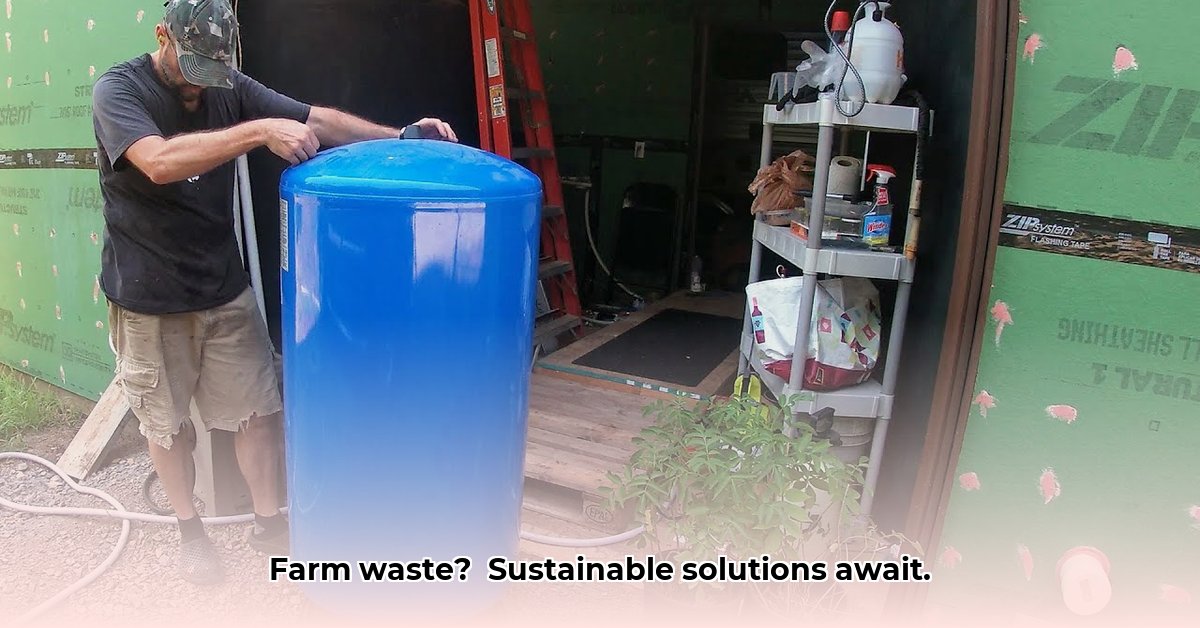
Many farmers utilize readily available resources like 55-gallon plastic drums (often sourced from Tractor Supply) and burn barrels for waste disposal. However, increasingly stringent environmental regulations and a growing awareness of sustainability necessitate a shift toward more responsible practices. This guide explores cleaner, more efficient alternatives for managing farm waste, enhancing both environmental stewardship and farm profitability. For more information on drum reuse, check out this useful resource.
The Downside of Traditional Waste Disposal Methods
Burning farm waste in burn barrels, while seemingly convenient, presents significant environmental drawbacks. Smoke plumes release greenhouse gases and particulate matter, harming air quality and potentially violating local air pollution regulations—leading to costly fines. Furthermore, ash residue may contaminate soil and water resources, compromising long-term soil health and crop yields. Is this truly a sustainable approach to farm management? The answer, clearly, is no.
Sustainable Alternatives: Revolutionizing Farm Waste Management
Fortunately, several proven methods offer environmentally sound and economically viable alternatives to traditional waste disposal. These approaches, while potentially requiring initial investment, deliver long-term benefits such as improved soil health, cleaner air, and compliance with environmental regulations.
1. Composting: Nature's Efficient Recycling System
Composting is a natural process that transforms organic matter (e.g., plant scraps, food waste) into nutrient-rich compost, ideal for smaller farms. This highly effective method essentially creates a free, organic fertilizer, improving soil structure and fertility.
How to Build and Maintain a Compost System:
- Location Selection: Choose a shaded area with adequate drainage to prevent waterlogging.
- Material Procurement: Gather a mix of "brown" materials (carbon-rich; dried leaves, straw) and "green" materials (nitrogen-rich; grass clippings, vegetable scraps). Maintain a roughly equal ratio.
- Pile Construction: Create a compost pile, ensuring adequate aeration by regular turning (at least weekly). This activity boosts microbial activity, accelerating the decomposition process.
- Moisture Management: Aim for a consistently moist environment – think the consistency of a wrung-out sponge. Avoid both excessive dryness and waterlogging.
- Maturation: The composting process takes time. Expect several months for complete decomposition, resulting in dark, crumbly compost ready for application to your fields.
2. Anaerobic Digestion: Unlocking Energy and Fertilizer from Waste
Anaerobic digestion leverages microorganisms to break down organic waste in the absence of oxygen. This process yields biogas (a renewable energy source) and digestate (a valuable fertilizer alternative). Although requiring a larger initial investment and specialized equipment, this technology becomes increasingly cost-effective for larger farms, offering dual benefits of energy generation and soil amendment. Further research is ongoing to optimize system efficiency and reduce associated costs.
3. Recycling and Repurposing: Maximizing Resource Utilization
Responsible farm waste management extends beyond organic waste. Properly sort and recycle plastics, metals, and other recyclable materials according to your local guidelines. Reimagine the uses of 55-gallon plastic drums; repurpose them for storage or other farm-related activities, extending their lifespan and minimizing waste.
Choosing the Right Solution for Your Farm
The optimal approach to farm waste management is determined by factors such as farm size, waste composition, and resource availability. For smaller operations, composting is often the most practical and cost-effective method. Larger farms may find anaerobic digestion more feasible. Regardless of scale, responsible waste management is a cornerstone of sustainable farming.
The Responsible Use of 55-Gallon Plastic Drums
While 55-gallon drums (like those readily available at Tractor Supply) serve useful purposes for storage, their long-term environmental impact should be considered. Prioritize reuse whenever possible and always ensure proper disposal to avoid environmental contamination.
Building a Sustainable Future: Collaboration and Innovation
Effective sustainable waste management requires a collaborative effort among farmers, local governments, and research institutions. Shared composting facilities, cooperative anaerobic digestion plants, and community recycling programs can facilitate the adoption of environmentally sound practices, overcoming financial barriers and fostering knowledge exchange. Ongoing research promises further advancements in sustainable waste management technologies, shaping the future of responsible farming practices.
Key Takeaways: Sustainable Farm Waste Management
- Environmental Responsibility: Sustainable waste management protects the environment and prevents air and water pollution.
- Economic Viability: Methods like composting offer cost savings by creating valuable soil amendments.
- Regulatory Compliance: Adopting sustainable practices ensures compliance with environmental regulations, preventing penalties.
- Technological Advancements: Anaerobic digestion, while requiring initial investments, offers long-term resource benefits.
- Resource Optimization: Repurposing 55-gallon drums and recycling materials reduces waste and conserves resources.
By embracing these sustainable practices, farmers contribute to a healthier planet while securing the long-term health and profitability of their operations.